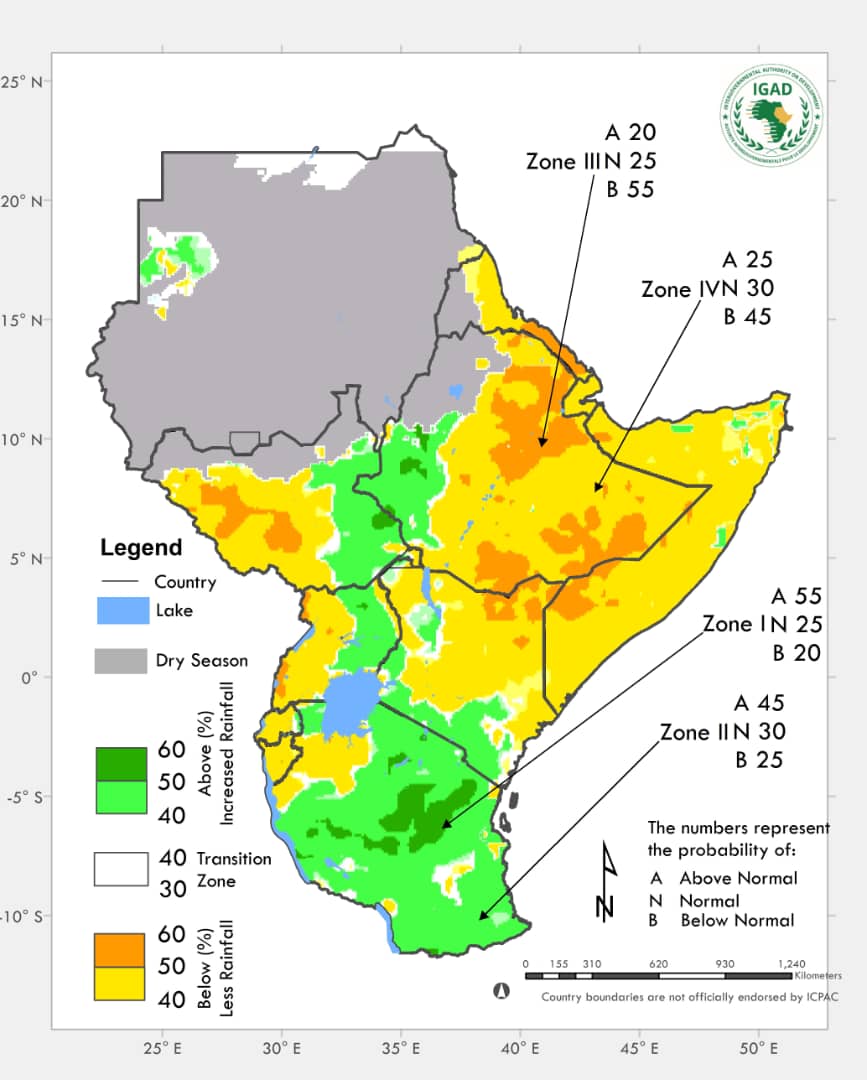Sitti Zone, a part of Ethiopia’s Somali Region, is facing a mounting crisis fueled by two interconnected forces: prolonged drought and violent conflict. While the zone has long relied on two critical rainy seasons—Gu/Dirra (March to May) and Karan (July to mid-September)—to sustain its pastoralist population, recent forecasts paint a bleak picture for 2025.
According to the 69th Greater Horn of Africa Climate Outlook Forum (GHACOF69), there is a high probability of below-average rainfall, increasing the risk of drought in Sitti and other parts of northeastern Ethiopia. But drought is only part of the problem.
What makes Sitti’s situation especially precarious is its status as one of the Somali Region’s conflict-ridden zones. Years of violent clashes have left deep scars on the local population and displaced thousands from their homes. Many of these internally displaced persons (IDPs) from western Sitti now live scattered across the zone, struggling to survive in makeshift shelters with limited access to basic services. The convergence of conflict-driven displacement and climate-induced drought is pushing Sitti to the brink.
The Climate Crisis in Sitti
For the 822,000 people living in Sitti Zone, life revolves around livestock. An estimated 75-85% of the population are nomadic pastoralists who depend on sheep, goats, cattle, and camels for their livelihood. In normal times, the rains bring much-needed pasture and water for their animals. But when the rains fail—as they have increasingly done in recent years—the consequences are devastating.
With water and pasture in short supply, livestock is becoming weaker and less productive. Milk and meat production have plummeted, and the market value of livestock has dropped dramatically. This leaves pastoralists trapped in a vicious cycle of poverty and food insecurity, unable to feed their families or recover from one drought before the next one hits.
Conflict and Displacement – A Compounding Crisis
While drought alone would be enough to challenge any community, Sitti Zone must also contend with the fallout from years of conflict. The zone has become a refuge for displaced families who were forced to flee violence in western Sitti. These IDPs, who once had homes and herds of their own, now live in scattered settlements, dependent on unreliable humanitarian aid that is often insufficient to meet their needs.
The presence of so many displaced people has put additional pressure on Sitti’s limited resources. Water, food, and grazing land—already scarce due to the drought—are stretched to the breaking point.
Historical negligence
Historically, Ethiopia’s Somali Region has been one of the most neglected areas when it comes to drought response, despite its long-standing struggles with climate disasters, food insecurity, and displacement, the region faces worsening droughts that have decimated crops, killed livestock, and dried up water sources, leaving local communities and internally displaced persons (IDPs) in dire need. However, the challenges in the Somali region are often downplayed, and inadequate resources are allocated to mitigate the rising malnutrition and food shortages exacerbated by climate change.
This neglect has been compounded by corruption scandals involving the theft and diversion of food aid, further deepening the crisis. Reports suggest that some food aid intended for drought-affected communities, including IDPs, has been manipulated by local forces and even diverted to support Ethiopia’s national army. This betrayal of humanitarian trust has left already vulnerable populations with little to no access to essential resources, worsening hunger, malnutrition, and displacement. As a result, the Somali Region teeters on the brink of a humanitarian catastrophe.
Drought Imminent if Rainfall Fails
Somali region, particularly in Sitti Zone, is already experiencing severe water and grazing shortages due to prolonged dry conditions, with predictions of below-average rainfall intensifying concerns. According to the IGAD Climate Prediction and Applications Centre (ICPAC), the March to May (MAM) 2025 rainy season, which usually provides up to 60% of the annual rainfall in parts of the Greater Horn of Africa, is expected to be insufficient. Below-normal rainfall is projected across key areas, including Somalia, eastern and northern Kenya, southern and northeastern Ethiopia, Djibouti, and parts of Eritrea, Uganda, and Tanzania. By late March, the Somali Region has yet to experience any significant rainfall, worsening the existing drought conditions. Immediate action is urgently needed to mitigate the impact on livelihoods, prevent food and water shortages, and support vulnerable communities in the affected areas.
What Needs to Be Done?
Sitti Zone’s crisis is not inevitable, nor is it unsolvable. But, addressing it will require urgent, coordinated action from the Ethiopian government, international aid agencies, and local communities. Here are some key steps that must be taken:
1. Invest in Water Infrastructure: Building water storage and harvesting systems can help communities survive future dry spells.
2. Support Livelihoods: Providing livestock feed, veterinary services, and drought-resistant crops can help pastoralists protect their herds and diversify their income.
3. Assist IDPs: Displaced families need more than emergency aid—they need access to education, healthcare, and opportunities to rebuild their lives.
A Call to Action
Sitti Zone stands at a crossroads. If nothing is done, the combined impact of drought and displacement will continue to push the region deeper into crisis. But with the right investments and policies, it is possible to break the cycle of poverty and build a more resilient future for the people of Sitti.
The question now is whether we will act in time—or wait until it is too late.
Mohamed Gafdiid | X: @Gafdiid7


COMMENTS